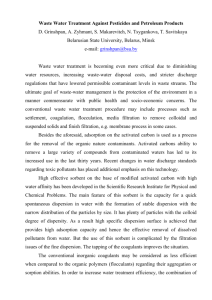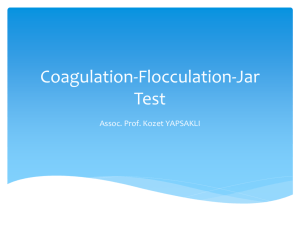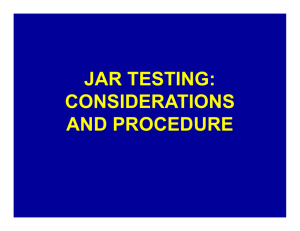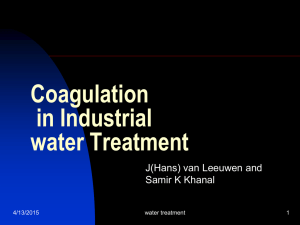Jar Testing Procedures: Coagulation & Flocculation
advertisement
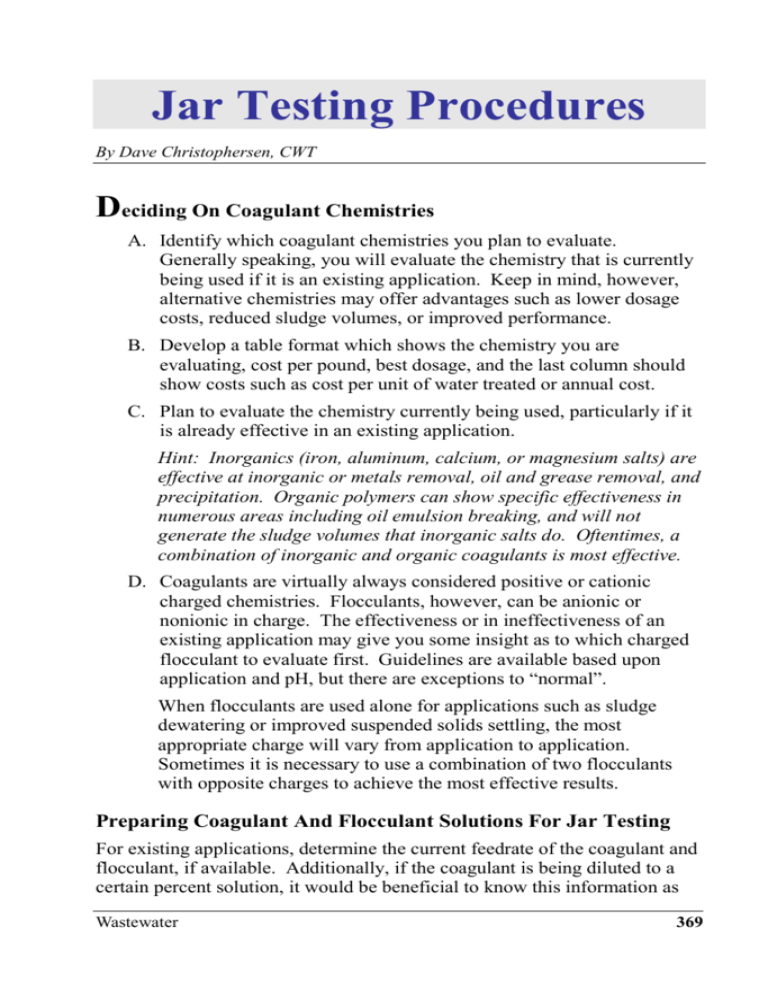
Jar Testing Procedures By Dave Christophersen, CWT Deciding On Coagulant Chemistries A. Identify which coagulant chemistries you plan to evaluate. Generally speaking, you will evaluate the chemistry that is currently being used if it is an existing application. Keep in mind, however, alternative chemistries may offer advantages such as lower dosage costs, reduced sludge volumes, or improved performance. B. Develop a table format which shows the chemistry you are evaluating, cost per pound, best dosage, and the last column should show costs such as cost per unit of water treated or annual cost. C. Plan to evaluate the chemistry currently being used, particularly if it is already effective in an existing application. Hint: Inorganics (iron, aluminum, calcium, or magnesium salts) are effective at inorganic or metals removal, oil and grease removal, and precipitation. Organic polymers can show specific effectiveness in numerous areas including oil emulsion breaking, and will not generate the sludge volumes that inorganic salts do. Oftentimes, a combination of inorganic and organic coagulants is most effective. D. Coagulants are virtually always considered positive or cationic charged chemistries. Flocculants, however, can be anionic or nonionic in charge. The effectiveness or in ineffectiveness of an existing application may give you some insight as to which charged flocculant to evaluate first. Guidelines are available based upon application and pH, but there are exceptions to “normal”. When flocculants are used alone for applications such as sludge dewatering or improved suspended solids settling, the most appropriate charge will vary from application to application. Sometimes it is necessary to use a combination of two flocculants with opposite charges to achieve the most effective results. Preparing Coagulant And Flocculant Solutions For Jar Testing For existing applications, determine the current feedrate of the coagulant and flocculant, if available. Additionally, if the coagulant is being diluted to a certain percent solution, it would be beneficial to know this information as Wastewater 369 well. Generally speaking, coagulant chemistries are fed neat and are not made down into solutions. Determine the flocculant solution being prepared. Emulsion polymers require strong sheer force mixing and some age time to be inverted to full activity. Again, determine what the current make-down solution is for the existing application and dosage rate. Base the dosage of the flocculant aid on product dosage, not the make-down solution dosage. Make-down solution dosages for flocculants are normally 0.1 – 1% solutions. A. Coagulant Solutions Prepare your coagulant solution based on the information generated in item A and the size of the beakers you plan to use in your jar tests. For example, if your coagulant dosage is within the range of 5 to 100 ppm, you may want to make a 1% solution of the coagulant to add to your 1,000 ml beakers. This solution strength would result in you adding approximately 0.5 mls – 10 mls of your 1% solution to 1000 mls sample water. However, if your coagulant dosage is several hundred parts per million or greater, it would be better to make a 5 of 10% solution to be added to your 1,000 ml beakers. Making a 1% Solution of a Coagulant with a Specific Gravity of 1.2 1. Determine the amount of solution to be made (200 mls). 2. Amount of coagulant product needed = mls of 1% solution to be made, multiplied by 1%, and divided by specific gravity of coagulant = 200 × .01 ÷ 1.2 = 1.67 mls. (2 grams) 3. Place amount of coagulant needed into approximately 198 mls (198 grams) of distilled water, for a 1% solution. Note: If 10% solution is made, 16.7 mls (20 grams) of coagulant would be placed into 180 mls (180 grams) of distilled water. 4. The solution can be mixed by placing it in a clean sample bottle, securing a lid, and shaking it vigorously for 30 seconds to 1 minute. B. Flocculant Solutions Make the appropriate percent solution for the flocculant to be tested and the feed equipment to be used. If you cannot determine this information, a good starting point is a 0.1% Wastewater 370 solution. The calculations for determining the amount of emulsion flocculant product to use are the same as for coagulant; however, the mixing procedure requires much more agitation and mixing. Making an Emulsion Flocculant Solution 1. Determine the amount of solution to be made (100 mls). 2. Amount of flocculant product needed = number of mls of solution to be made, multiplied by the percent solution to be made, divided by the specific gravity of the flocculant = 100 × 0.001 ÷ 1.05 = approximately 0.1 mls (0.1 grams) of flocculant product. 3. Amount of water for solution = 100 grams – 0.1 gram flocculant product = 99.9 grams (99.9 mls) of water. 4. Place 99.9 mls of water into a plastic 200 ml mix cup. 5. Using a Braun mixer (or similar), begin mixing the distilled water in the mix cup. A stir rate of 800-1000 rpm is desired. 6. Shake the emulsion sample for 5-10 seconds until the product is uniform. 7. Immediately add 0.1 mls of flocculant product into the vortex area of the water as it is mixing. 8. Mix for a total of approximately 1 minute while turning the mixer section from one side to the other side of the mix cup for approximately 20 second intervals. 9. Discontinue mixing. Allow emulsion flocculant mixture to drain from the Braun mixer into the cup and clean the mixer with a dry paper towel. 10. Ideally, turbulent mixing should continue for 30 minutes for most efficient unwinding of the polymer. At least 30 minutes should be provided with occasional mixing. Note: If a mixer is not available, invert the emulsion polymer as follows. (This method will yield less efficient inversion and unwinding of the polymer). a. Use a container with a lid. Measure the water out and add it to the container. b. Rapidly shoot the emulsion into the water using a syringe. With this method, target a 0.1% solution. c. Immediately cap the container and vigorously shake for 1 minute. Wastewater 371 d. Provide additional occasional moderate shaking for 30 minutes. The resulting solution should be white, translucent to opaque, and homogenous. Making a Flocculant Solution with Dry Polymers 1. Determine the amount of solution to be made (100 mls). 2. Generally, a 0.1% solution strength is a good amount, so weigh out 0.1 grams and add to 100 mls. (If you don’t have access to a metric balance, you can come close by using the brass dippers in the test kits as holding 0.1 grams of flocculant. A 0.1 gram plastic dipper will provide about 0.06 grams of dry flocculant. This will vary somewhat by the flocculant being used). 3. Slowly add the flocculant particles into the vortex of water, mixing at 800-1000 rpm, then offset and continue turbulent mixing for 30 minutes. Alternatively, add slowly to a container, cap it, and vigorously shake for 1 minute, then provide additional moderate shaking for 30 minutes. The resulting solution should be clear and homogenous. If fisheyes or globs are present, continue additional mixing. Testing Using existing plant operating data, determine the range of coagulant dosage and flocculant dosage you would like to evaluate in your jar test. In the first iterations of jar tests, you will probably be changing the coagulant dosages while maintaining a constant flocculant dosage. The proper coagulant chemistry and dosage is what you want to determine first. Sometimes, you may not even apply flocculant until you have correctly identified the most effective coagulant chemistry. Example: Plant is currently feeding a coagulant at 60 ppm and flocculant at 1 ppm. You have a 4-beaker gang stirrer and plan to dose the coagulants in the jars at 20 ppm increments, starting with 20 ppm. You will dose all the jars with 1 ppm of flocculant. Calculate the amount of 1% solution of coagulant added to 1,000 mls of water to achieve a dosage of 20 ppm. Determine what 1 ml of a 1% solution into 1,000 mls sample is equal to in mg/L or ppm. 1 ml of a 1% solution = 0.01 grams. Divide by 1,000 mls and 1 ml in 1000 mls = 0.00001 g/L. Multiply by 1,000,000 to get mg/L which is 10 mg/L (ppm) or a Wastewater 372 1% solution = 10,000 ppm. Dilute a 1 ml 1% solution with 1,000 mls of water to be tested. 10,000 ÷ 1,000 = 10 ppm. When using a 1% solution of coagulant and 1,000 ml jars, 1 ml of solution added = 10 ppm. For a 500 ml sample, 1 ml of a 1% solution = 20 ppm. Therefore, for jar 1, you will add 2 mls, add 4 mls to jar 2, 6 mls to jar 3, and 8 mls to jar 4 to have respectively 20, 40, 60, and 80 ppm of coagulant. Determine the amount of 0.1% flocculant solution added to 1,000 ml jars to achieve 1 ppm dosage. 1 ppm = (X mls of 0.1% solution multiplied by 0.001 divided by 1,000 mls of sample) multiplied by 1,000,000. X = 1 ml of 0.1% flocculant solution, therefore, we are going to add 1 ml of the 0.1% flocculant solution to achieve 1 ppm dosage to all four beakers. Adding the Coagulants and Flocculants to the Beakers And Evaluating the Effectiveness A. After the beakers have been filled to the 1,000 ml mark with the water to be tested, begin stirring the water at 100 rpm or maximum speed on the gang stirrer. B. Add the coagulant dosages to the beakers as previously determined; in this example, 20, 40, 60, and 80 ppm dosages. C. Allow the coagulant to mix at the rapid speed of 100 rpm for approximately 2 minutes, or try to duplicate the amount of agitation and mix time provided by the existing plant treatment system. The timeframe should be correlated with the retention time associated with the actual injection pint of the coagulant in the current application. Generally, the turbulence and mixing achieved at the injection point in the application is much greater than can be generated in a jar test. Square jars provide more turbulence than round jars. D. During this fast mix procedure, observe the jars very closely to determine which dosage yields the first floc or formation of particles. Make note which dosage showed this characteristic. E. As the 2-minute rapid mix time comes to an end, observe which dosage yields the largest floc size and clarity of water. F. After the 2-minute rapid mix time, reduce the speed to a slower mix of approximately 30-40 rpm. Allow the jars to mix at this Wastewater 373 lower speed for approximately 3 minutes or the times correlating to the plant system. During this period, continue to evaluate the floc size and clarity of water. G. At the end of the slow mix, turn the stirrers off completely and allow the floc to settle to the bottom of the jar, or possibly float, depending on the treatment application. Make note of which dosage yields the most rapid settling or floating rate, largest floc particles, and the clarity of water. After the jars have set for approximately 2 to 5 minutes, you can extract some water from the jars and run a turbidity analysis to determine more accurately which jar yields the best clarity water. Note: The above procedure was first run without any flocculant to determine the most cost-effective coagulant dosage. You should run the same procedure again and add the flocculant at the end of the 2-minute rapid mix period, but prior to reducing the speed to 40 rpm. After adding the flocculant at the high rapid mix speed, allow for an additional 30 seconds to 1 minute mixing to ensure that the flocculant is completely dispersed in the jar. Then reduce the speed to 30-40 ppm and continue to evaluate the water quality in the jar using the same procedure stated above. H. Evaluating Flocculant Chemistries. After the most effective coagulant has been determined, it is sometimes beneficial to determine which flocculant will yield large, stable floc particles and more rapid settling or flotation. Keep in mind that coagulant is the primary chemistry used for charge neutralization or precipitation and to initiate the formation of floc particles. The flocculant chemistry is used to increase the size of the floc particles produced and improve settleability, flotation, and clarity of the water. Also look for fines that remain. Good flocculation will leave minimal fines. 1. Determine the most effective range of coagulant chemistry. 2. Pick a coagulant dosage and vary the flocculant dosage in the four jars. For example, you may decide to try a slightly lower coagulant dosage than what your best jar test had previously shown without flocculant aid and vary the flocculant dosages in increments of 0.1 to 0.5 ppm. 3. Evaluate the jars based on the parameters previously stated. 4. Evaluate different flocculants with varying charges and percent actives. Wastewater 374 I. Wastewater Determination of the Most Cost-effective Program. Using a combination of operating costs generated on your cost comparison dosage sheet and performance characteristics using the jar test evaluation sheet, determine the most effective program for the client. Keep in mind, if you recommend an inorganic to replace an organic program, there may be increased costs associated with additional sludge haul-off or dewatering. Other items, such as the need for pH adjustment, should also be considered. 375 Wastewater 376 Wastewater 377

